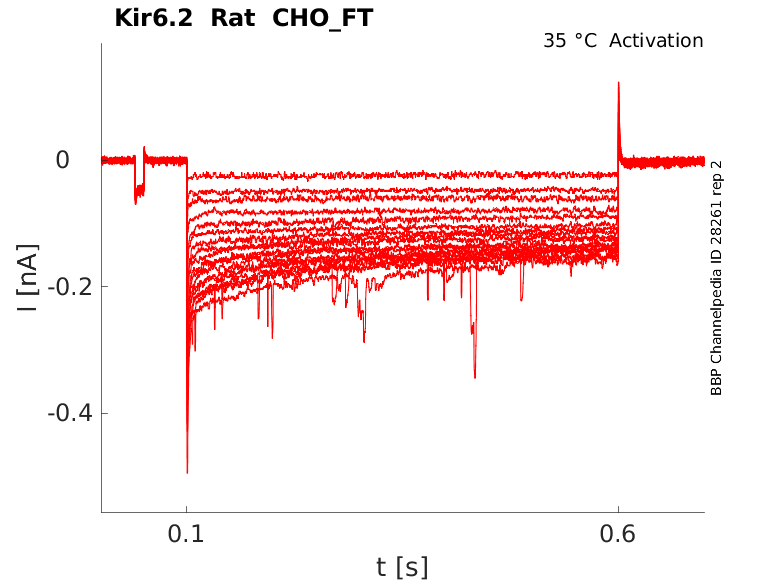Kir6.2
Description: potassium inwardly rectifying channel, subfamily J, member 11 Gene: Kcnj11 Alias: Kir6.2, kcnj11, BIR, HHF2, PHHI, IKATP, TNDM3
The ATP-sensitive K + (KATP) channels are potassium permeable ion channels regulated by the ratio of intracellular ATP and ADP concentrations. These channels were first discovered in cardiomyocytes and later found in various tissues, such as pancreatic β cells, pituitary tissue, skeletal muscle, brain, and vascular and nonvascular smooth muscle (Babenko et al., 1998a,b; Huang et al., 2006; Wu et al., 2000, 2006). There are differences in the functional, structural and pharmacological properties of various KATP channels in different tissues (Seino, 1999). Structurally, KATP channels are heteromers composed of inwardly rectifying K+ (Kir6.X) subunits and sulphonylurea receptors (SURs) (Babenko et al., 1998a [1059], b [1063]; Seino, 1999 [1060]). The Kir6.X subunits form a pore-forming structure through which K+ ions transverse the membrane, whereas SUR subunits assemble with the former to modulate the channel's function and to confer unique pharmacological properties to the channel complex (Coetzee et al., 1999 [496]; Miki et al., 2002 [1064]).
The gene KCNJ11 (also known as BIR; HHF2; PHHI; IKATP; TNDM3; KIR6.2; MGC133230) encodes Kir6.2, potassium inwardly-rectifying channel, subfamily J, member 11 This integral membrane protein has a greater tendency to allow potassium to flow into a cell rather than out of a cell, is controlled by G-proteins and is found associated with the sulfonylurea receptor SUR. Mutations in this gene are a cause of familial persistent hyperinsulinemic hypoglycemia of infancy (PHHI), an autosomal recessive disorder characterized by unregulated insulin secretion. Defects in this gene may also contribute to autosomal dominant non-insulin-dependent diabetes mellitus type II (NIDDM), transient neonatal diabetes mellitus type 3 (TNDM3), and permanent neonatal diabetes mellitus (PNDM). Multiple alternatively spliced transcript variants that encode different protein isoforms have been described for this gene.
http://www.ncbi.nlm.nih.gov/gene/3767
Experimental data
Rat Kir6.2 gene in CHO host cells |
||
|
Click for details 
25 °Cshow 29 cells |
Click for details 
35 °Cshow 20 cells |
|
Gene
Transcript
| Species | NCBI accession | Length (nt) | |
|---|---|---|---|
| Human | NM_000525.4 | 3412 | |
| Mouse | NM_010602.3 | 3115 | |
| Rat | NM_031358.3 | 3051 |
Protein Isoforms
Isoforms
Post-Translational Modifications
As octameric proteins KATP channels possess four pore-forming Kir subunits (Kir6.1 or Kir6.2) and four regulatory sulfonylurea receptor subunits (SUR1 or SUR2). The Kir subunit is a typical inwardly rectifying potassium channel, the SUR subunit is structurally a member of the ABC transporter superfamily. (Diehlmann [1066])
Kir6.2 predicted AlphaFold size
Methodology for AlphaFold size prediction and disclaimer are available here
The sarcolemmal KATP channels have been classified into two categories of different biophysical properties: large and small conductance (Quayle et al., 1997 [941]). The single channel conductance of the large conductance KATP channels, which are formed by Kir6.2/SURs, is about 55–90 pS under symmetrical 150 mM K+ or similar conditions (Babenko et al., 1998a [1059],b [1063]; Coetzee et al., 1999 [496]).
KATP channels present in heart cells consist of the specific combination of Kir6.2 and SUR2A subunits, whereas the other KATP channels contain Kir6.1 and SUR2B subunits in smooth muscle cells (Seino, 1999 [1060]).
Kir6.2 and SUR2A subunits are predominantly present in the sarcolemma of ventricular myocytes, consistent with the Kir6.2/SUR2A-subunit combi- nation in the sarcolemmal KATP channels (Kuniyasu et al., 2003; Singh et al., 2003 [1065]).
The ATP-sensitive K+ (KATP) channels are known to provide a functional linkage between the electrical activity of the cell membrane and metabolism. Two types of inwardly rectifying K+ channel subunits (i.e., Kir6.1 and Kir6.2) with which sulfonylurea receptors are associated were reported to constitute the KATP channels. (Wu [209])
KATP channels are inhibited by physiological intracellular ATP and are activated by increasing intracellular ADP/ATP ratio, e.g. as a result of energy depletion, hypoxia or metabolic stress. As a consequence, K+ efflux leads to hyperpolarization of the membrane, protecting the cell from over-excitability and cell death (Miki et al., 2001 [1064]).
Pinacidil and dinitrophenol stimulated large and small KATP channels (i.e. those involving Kir6.2 and Kir6.1 respectively) and both were sensitive to be blocked by glibenclamide. (Wu [209])
References
Ishida-Takahashi A
et al.
Cystic fibrosis transmembrane conductance regulator mediates sulphonylurea block of the inwardly rectifying K+ channel Kir6.1.
J. Physiol. (Lond.),
1998
Apr
1
, 508 ( Pt 1) (23-30).
Wu SN
et al.
Identification of two types of ATP-sensitive K+ channels in rat ventricular myocytes.
Life Sci.,
2007
Jan
2
, 80 (378-87).
Coetzee WA
et al.
Molecular diversity of K+ channels.
Ann. N. Y. Acad. Sci.,
1999
Apr
30
, 868 (233-85).
Quayle JM
et al.
ATP-sensitive and inwardly rectifying potassium channels in smooth muscle.
Physiol. Rev.,
1997
Oct
, 77 (1165-232).
Babenko AP
et al.
A view of sur/KIR6.X, KATP channels.
Annu. Rev. Physiol.,
1998
, 60 (667-87).
Seino S
ATP-sensitive potassium channels: a model of heteromultimeric potassium channel/receptor assemblies.
Annu. Rev. Physiol.,
1999
, 61 (337-62).
Babenko AP
et al.
Reconstituted human cardiac KATP channels: functional identity with the native channels from the sarcolemma of human ventricular cells.
Circ. Res.,
1998
Nov
30
, 83 (1132-43).
Miki T
et al.
Mouse model of Prinzmetal angina by disruption of the inward rectifier Kir6.1.
Nat. Med.,
2002
May
, 8 (466-72).
Singh H
et al.
Distribution of Kir6.0 and SUR2 ATP-sensitive potassium channel subunits in isolated ventricular myocytes.
J. Mol. Cell. Cardiol.,
2003
May
, 35 (445-59).
Diehlmann A
et al.
K(ATP) channels in mesenchymal stromal stem cells: Strong up-regulation of Kir6.2 subunits upon osteogenic differentiation.
,
2011
Aug
4
, ().
Credits
To cite this page: [Contributors] Channelpedia https://channelpedia.epfl.ch/wikipages/54/ , accessed on 2025 Dec 25